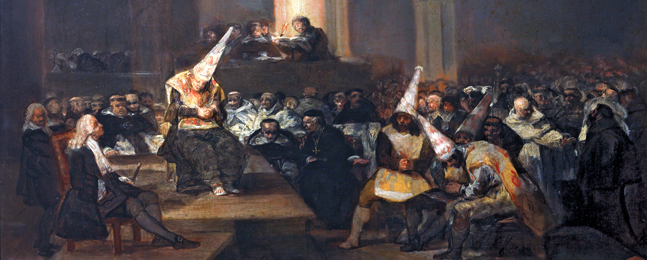When History Did Not Predict the Future

Francisco de Goya, "The Inquisition Tribunal" (1812-19)
by Lawrence Goodman
In 1934, the Romanian-Jewish scholar Valeriu Marcu penned a book about the Spanish Inquisition, “The Expulsion of the Jews From Spain.” Officially banned in Germany because its author was Jewish, the book still found its way into the hands of German and German-Jewish intellectuals, and was widely read.
Three years later, the Jewish Museum Berlin opened an exhibition on Isaac Abravanel, a 15th-century Portuguese rabbi and scholar who rose to prominence during the Spanish Inquisition. Although Kristallnacht (the “Night of Broken Glass”) was still a year away, this seemingly obscure museum attraction drew great interest, and not just among Jews. Carl Schmitt, a leading Nazi theorist who became known as “the crown jurist of the Third Reich,” found the exhibition fascinating.
According to Eugene Sheppard, associate professor of modern Jewish history and thought, the Inquisition was the historical time period German and German-Jewish intellectuals in the 1930s thought most comparable to their own. Like people throughout history, they looked to the past as a way of understanding their present.
Sheppard has uncovered a sudden proliferation of references to the Inquisition in German writings from that time. Years before the Final Solution began, German Jews clearly faced an ominous future under Hitler. They believed their fate would be similar to that of the Jews in medieval Spain — expulsion from their home country. Such an outcome, Sheppard says, was judged disastrous. In retrospect, it seems like wishful thinking.
German Jews “get that something catastrophic is about to happen,” he says. “The problem is that the Spanish model was not catastrophic enough.”
Marcu’s book, published a year before the Nuremberg Laws stripped German Jews of their citizenship, is filled with historical errors and disproven assumptions. But that’s not the point, says Sheppard. “Marcu wrote in a way that made it obvious to every German reader that he was really writing about the present,” he says.
The epigraph in Marcu’s book quotes 19th-century German historian Leopold von Ranke on the Inquisition: “In no country have the prejudices concerning a distinction between pure and impure blood become so firmly implanted as in Spain. […] To [the Spanish people] it appeared as much an error of blood not to be of the pure Catholic faith as an error of opinion, hence the value they attributed to purity of blood, to limpieza.” Substitute a few words, and von Ranke could be describing Nazi Germany.
Marcu was also interested in Abravanel, who had offered the Spanish monarchy a large sum of money to rescind the order expelling Jews. Though Abravanel wasn’t successful, Sheppard says German Jews still hoped a similar approach might work with the Nazis.
Abravanel gave German Jews further cause for optimism. After he was driven out of Spain, he moved to Italy, where he managed to regain some of his prominence and wealth. German Jews in the 1930s didn’t know where they would wind up if Hitler expelled them, but they could at least cling to the hope that they might thrive there.
Sheppard has found that Schmitt, the Nazi legal scholar, became bizarrely obsessed with Abravanel’s apocalyptic prophecies. In his writings, Abravanel predicted a climactic clash between civilizations, symbolized by a battle between the biblical monsters Leviathan and Behemoth, who would fight each other to a draw, then be slain by the Messiah. Afterward, men and women would gather to eat the monsters. “The Lord of hosts shall make unto all people […] a feast of fat things, of fat things full of marrow,” the religious scholar wrote.
Schmitt convinced himself Leviathan and Behemoth represented England and Germany, destined to go to war against each other. He worried that if Germany exiled its Jews, the Messiah would come, and the Jews would get revenge by devouring whatever was left of the two countries.
In a time with truly no precedent, both the Germans and the Jews got their predictions terribly wrong. Again and again, Sheppard’s research shows how tenuous a guide to the future history can be.
